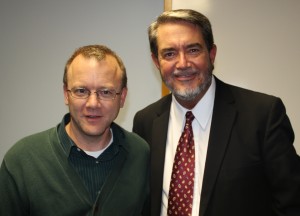Converts to Catholicism from various denominations of Christianity may attribute, at least in part, their conversion to the writings and teaching of Dr. Scott Hahn. Many years ago when I was living in Burtonsville, my friend Mike, a devout Catholic, gave me a book written by Dr. Hahn, an ex-Protestant theologian whose learning led him to the Catholic Church where he now resides as a scholar and apologist. With marginal interest I skimmed the book entitled Rome, Sweet Home, not entirely interested in what I thought were the complicated mechanisms of the Catholic traditions of Christianity, figuring that I’d “been there, done that”[1]. I handed the book to my ex-Catholic mom who was the best pitch for why I wasn’t a Catholic anymore. Understand that I wasn’t invalidating Catholicism, nor was I ever anti-Catholic, I just thought that it wasn’t the denomination[2] for me. To be honest, I had harbored some doubts about doctrinal items but then, in my mind, all denominations had their strange markings: no dancing, no drinking, no musical instruments, snake handling, women cover their heads, speaking in tongues, slain in the spirit, prophecy and other whistle-evoking distinctions. And that always struck me odd; it seemed every denomination had some preoccupation with an aspect of Christian teaching blown to the extreme and made into a denomination in its ultimate manifestation. This provided a certain liberty to do what I wanted because, after all, no one could agree on the color of an orange. I also chalked it up to God liking variety—seemed reasonable but then maybe not entirely true.
Fast forward to recent years when another friend started handing me Lighthouse Media CDs which I would listen to—still defensively–on my commute. Some of these were testimonies from converts but many were teachings from Catholic apologists like Patrick Madrid, Fr. Barron and Dr. Scott Hahn. Hahn was particularly interesting since, due to his Protestant background, he emphasized the teaching of scripture and the fullness of Catholic conformity. One of the first teachings I heard from him was that on the Eucharist under the scrutiny of John 6 and this blew me away. He’s also did one on the office of the pope and that surprised me too. Finally, his book called The Lamb’s Supper talked about Revelation in ways non-Catholic Christians never hear—it was striking.
During my RCIA last year as I was quietly moving toward conversion I visited my Mom in her new duplex where she still had been unpacking. I had not planned to share with her the spiritual changes in my life when, suddenly, she handed me a book that she thought belonged to me—Rome, Sweet Home. To think it resurfaced then after 15 years. Of course this unleashed a torrent of dialog and when I brought the book home I read it all.
Fast forward again and the point of my post. As many know I enrolled in Christendom College Notre Dame Graduate School this fall working my way toward a Master’s in Theology—-uh Catholic Theology—uh Rather Orthodox Catholic Theology. Only a few weeks into it and the small student body was treated to a visit from none other than Dr. Scott Hahn. Now normally, Dr. Hahn will speak a popular message comprehensible to the laity and those with some biblical understanding. But this special audience got an uncut academic dose based on his new book Politicizing the Bible — a talk which almost went entirely over my head. Let’s just say that while most of the audience gazed on nodding with index finger leaning against the side of their head intellectual like, I stared out like Tennessee Tuxedo’s dimwitted side kick, Chumly, wondering if I should ask Mr. Whoopie. Like listening to a Shakespeare play it takes a while to get your “sea legs” in such matters and in the end I started getting Hahn’s drift.
No doubt Dr. Scott Hahn was extremely influential in my conversion. Although it is rare that people convert based on information alone, at least when God changed my heart, my mind was ready for it.

